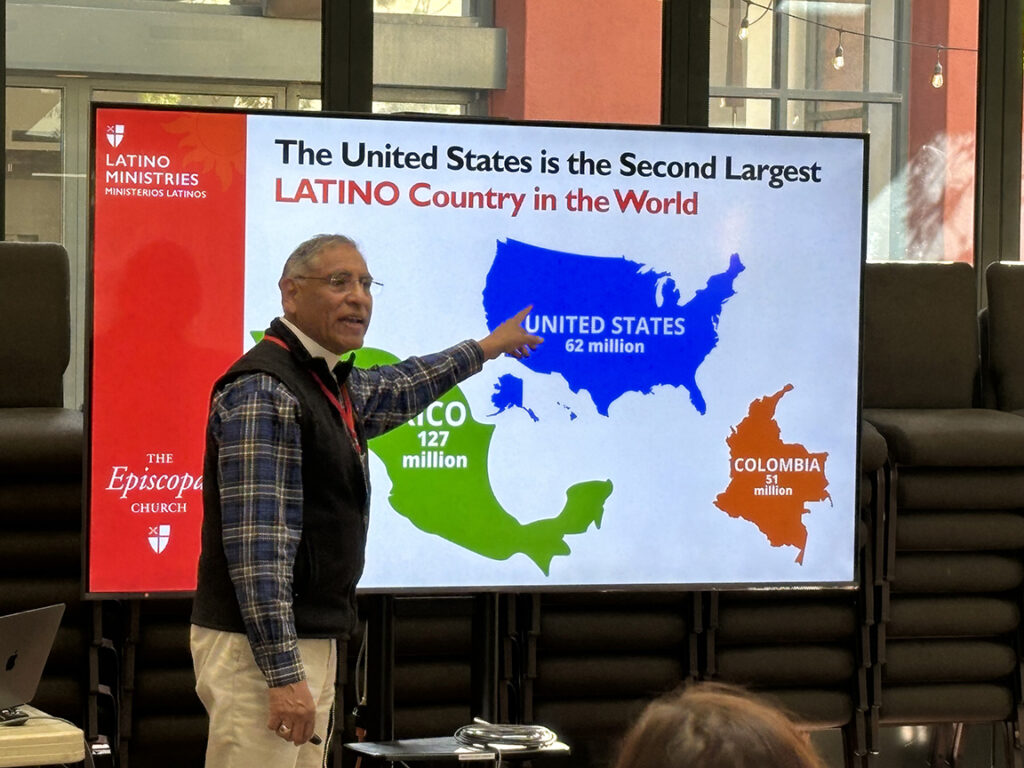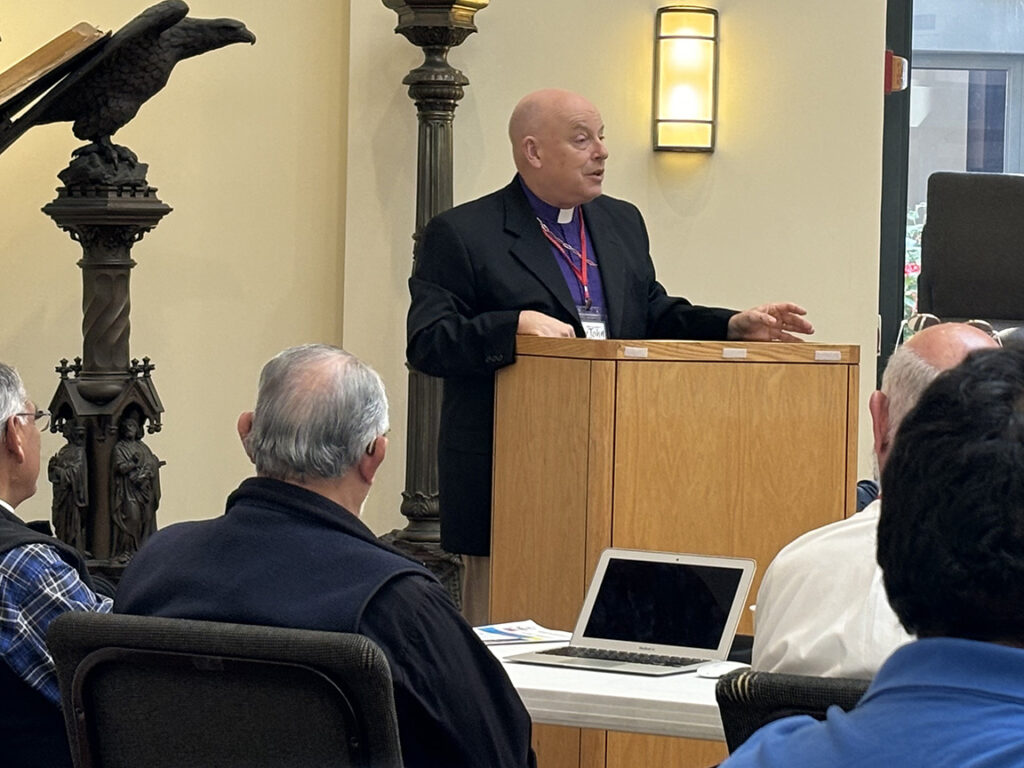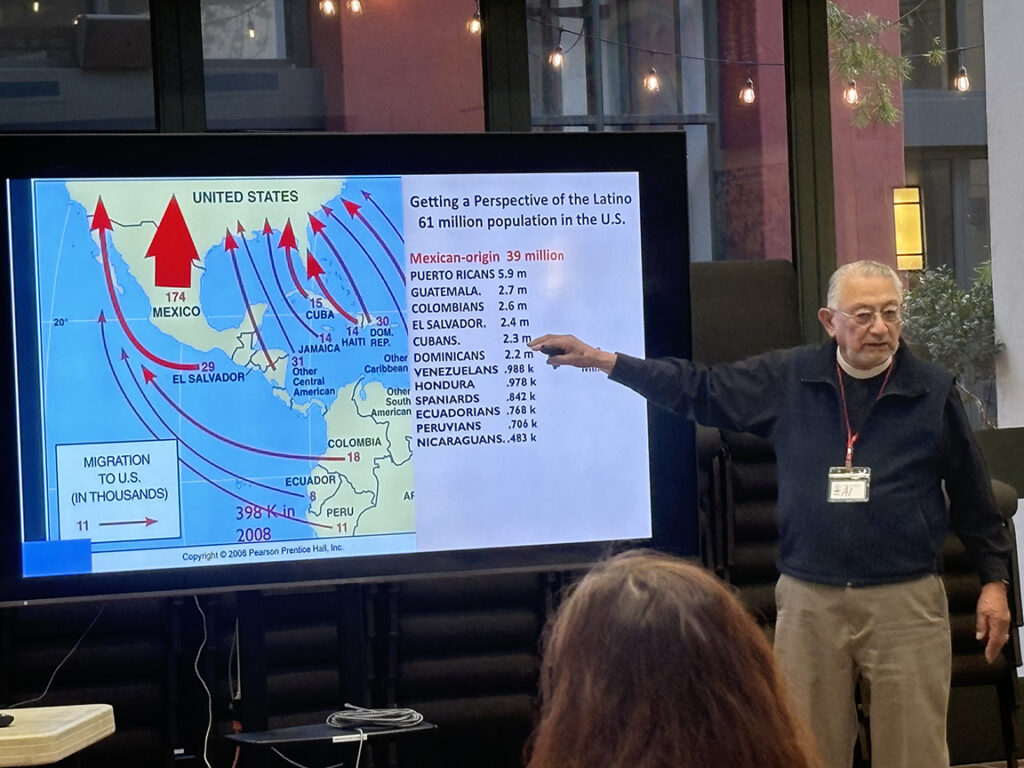
Anthony Guillen, missioner for Latino/Hispanic Ministries for The Episcopal Church, explains current demographics at the New Camino seminar. Photos: Keith Yamamoto
[The Episcopal News – April 10, 2024] “Se Habla English” is a new model of ministry that offers a fresh approach to traditional Latino outreach by providing second-, third-, and fourth-generation Latinos, or “Later Generation Latinos,” worship in English yet within their familiar cultural context, the Rev. Carlos Ruvalcaba told a recent New Camino gathering at St. Paul’s Commons in Los Angeles.
LGLs represent two-thirds of the overall Latino population in Southern and Central California, yet Latino ministry has traditionally been focused on the newly arrived, primarily Spanish-speakers, said Ruvalcaba, chair of the diocesan Program Group on Latino/Hispanic ministries, which hosted the March 22 – 23 gathering.
“Latino ministry is not static; one of the strengths of The Episcopal Church has been to allow each person or group to worship in their own language,” but a downside has been separation and inability to connect with one another, he said. “One role for the church today is to risk intercultural exchange, to risk reaching out across difference, to risk learning a little of another language – but even more, to risk having one’s heart be open to another cultural context.”
Bishop John Harvey Taylor welcomed the Rev. Canon Anthony Guillen, The Episcopal Church’s missioner for Latino/Hispanic Ministries, and the Rev. Al Rodriguez, Latino cross-cultural advisor for the Diocese of Texas, who led the gathering and who helped create New Camino, or new way, a ministry model to raise awareness, and offer strategies and tools to churches for their local community and neighbors.
“We now undertake in a new generation, in earnest, to open our hearts and minds to the rich diversity of our neighborhoods, folks who may not primarily speak Spanish but who deserve and desire and need, particularly in a majority white cultural political setting, and deserve culturally attuned ministry,” said Taylor, who also wrote about his experience at the seminar on his blog.

Bishop John Harvey Taylor welcomes attendees at the New Camino seminar.
Dispelling myths; raising awareness
About 28% of Latinos today “are completely checked out” of church or fall into the category known as “nones” (those who do not identify with any church affiliation), yet represent a rich evangelistic opportunity, Guillen told the gathering of about 40, representing at least 14 Los Angeles diocesan congregations.
“Imagine in another 20 years what that percentage will be,” Guillen said. “We have been given the opportunity today to invite people to a faith community that welcomes them, that allows them to think and to ask questions, to be fed in so many different ways – but the clock is ticking.”
Preconceived notions and misunderstandings about Latinos often hamper outreach, including associating Latinos with poverty or residing mainly in border towns, and with being primarily Mexican, Guillen said. He recalled that after sharing demographics of local Latinos with members of a diocese in the South, he was approached by three clergy people whose congregations were in heavily populated areas. “They said to me, ‘We’ve been talking about this, and we’ve never seen a Latino in our neighborhood.’ It helps to get out into your neighborhood and meet the people there. It doesn’t occur to us, we don’t look, we don’t inquire and therefore here we are. In many cases, these were small churches that had potential to grow but were doing nothing to reach out to the community.”
Guillen said another misconception is that “people equate Latinos with poverty,” Guillen said. “Everybody assumes that we’re poor and we have been traditionally at the bottom of the scale. However, that is changing.”
An NBC News report a year ago documented the overall increase in Latino salaries and the subsequent economic impact: “If U.S. Latinos were their own country, their gross domestic product would rank the fifth largest in the world.”
“Latinos are spending more,” Guillen said. “We represent a $2.8 trillion economic engine for the country.”
Similarly, a growing Latino population in Louisiana has resulted in an expansion of Latino-owned businesses and opportunities. Across the nation and in San Diego, Latinos represent the fastest growth in new home ownership.
Often, Latinos/Hispanics are thought to be predominantly Mexican and to congregate in border towns, but that too has changed. The Latino/Hispanic population has expanded across the nation and hail from across Latin America and Central America, including Puerto Rico, Bolivia, Peru, El Salvador, Guatemala, Ecuador, Mexico, Venezuela, Colombia, Cuba, Dominican Republic, Honduras and elsewhere — each representing variations of language and culture, Guillen said.

Latino/Hispanic Americans come from all over Central and South America – not just from Mexico, Al Rodriguez explains in his New Camino presentation.
Emerging paradigms, reaching out
Many churches are still doing Latino ministry “like it was done 50 years ago in The Episcopal Church” which is understood as Spanish-speaking only, Rodriguez told the gathering. “But the world ain’t the same as it was 50 years ago, and neither is the Latino population.”
LGLs, on the other hand, “represent an untouched and fertile ground for evangelization. They are all around us but they seem to be invisible. Why? Because many of them are in the mainstream of American society. Two-thirds of the Latino population in the U.S. is not on the radar of The Episcopal Church.” Ministry models must incorporate both groups — the newly arrived as well as subsequent generations, he said.
“It’s time to take the cultural blinders off and realize that ministry has to adapt and evolve – and not just for Latinos. Much of what we say is relevant to African- and Asian-Americans, as well as to Native Americans,” he said.
“A lot of the same acculturation dynamics that we are talking about are present in other groups in The Episcopal Church … (and) we recognize that the future of The Episcopal Church has to be a cosmopolitan, multicultural church.”
Marketing is another important outreach tool, said Guillen who served as rector of All Saints Church in Oxnard for 13 years before taking his current position with The Episcopal Church.
“Most of our church signs are pathetic,” he said. “I drive around and see church signs everywhere. We speak in code. We have this Episcopal shield that nobody knows what that is, except us. We only seem to want to reach out to Episcopalians.
“Our signage often doesn’t help us and it certainly isn’t inviting, even if it says ‘we welcome all.’ Most people know it doesn’t mean them. If we want to send a message, we have to use words that speak. Any business knows how to sell a product based on their target audience.”
He added: “The word bienvendios — it doesn’t mean what you think, but it does say welcome. If somebody sees that, they might be prone to go inside your church.”
Symbols can also be a deterrent to welcoming Latinos, he said. “The U.S. is one of the very few places where you see an American flag at a church. You go to Latin America and the only place a flag is is in a federal or state building. An immigrant is not going to go to a building with an American flag. That’s a message we give – not intentionally, but we give it anyway.
He noted that businesses like Loews prominently display photographs of their Spanish-speaking employees. “If we put a sign that says ‘se habla English’ we let them know we’re interested.”
Using misa, the Spanish word for mass, instead of the words Eucharist or Communion in signage is also helpful, he said. “For most Roman Catholics and for a lot of people, Eucharist is Greek, for one thing and doesn’t speak to everyone’s experience. Misa is understood; it is a code word for those who come from that background.
“When I was rector of All Saints, we changed Santa Eucarista to Misa and in three months we had tripled the number of people who came to the church.”
Wearing Roman-style clergy tab collars is another way to seem familiar to those who have been affiliated with the Catholic church, he said.
Seeing women clergy can also be off-putting for Latinos, but “what I’ve learned is that when people walk into a church and see a woman at the altar, there’s this internal processing that happens and it’s like, okay, yeah. Some might walk out, but most of the time, they don’t,” said Guillen.

Presenters Al Rodriguez, left, and Anthony Guillen flank Carlos Ruvalcaba, chair of the Diocese of Los Angeles’ Program Group on Latino/Hispanic Ministries, which hosted the New Camino seminar.
Latino? Hispanic? Latinx?
In response to a question about when to use the terms Latino or Hispanic, Guillen said Latino was meant to represent Latin America, “starting at the border, going to the tip of South America, But really, today the U.S. is Latin America. Latin America is not defined by language, but rather geography and culture.”
The problem is, “Latino is a male gender word so thus they came up with Latinx as a way to try to deal with that terminology, but only about 3% of Latinos use that term and nobody in Latin America uses it.”
Over half of Latinos don’t use either term, which are incorporated more by media, businesses and governmental agencies as defining terms, he added. It’s complicated. “When you ask most Latinos what they are, they’ll say, I’m Mexican, Puerto Rican, Guatemalan, whatever. I use the term Latino,” he said. “In my family we all use something different. My sister calls herself Chicana. Another sister calls herself American. Another sister calls herself Mexican American and another calls herself Hispanic.”
Seminar takeaways
For the Rev. Joy Magala, priest-in-charge under special circumstances at St. Mary’s Church (Mariposa) in Los Angeles’ Koreatown neighborhood, New Camino offered insight, prompting an April 28 debut of a Misa Oaxaquena, “trying to make our worship as close to what they love or what their experience at home was, so everyone is invited into the experience as well.”
The Rev. Stacey Forte-Dupree said she attended the conference to “learn how to minister to and with other ethnic groups. For so many years, The Episcopal Church has said we are a welcoming church. It’s time we moved beyond that to becoming a belonging church.
“For me, as a Black American, I often feel that I am still a visitor and my voice is only welcomed at Black occasions, like Martin Luther King services, Barbara Harris celebrations, Juneteenth. I guess our Latin or Hispanic siblings may feel the same way, so I was there to just get an understanding and to share and get a sense if that was the case. I wanted to learn from the people themselves and not so much second- or third-hand.”
While the Rev. Courtney Tan has been interim priest-in-charge for only three months at St. Peter’s Church in Santa Maria, she is already meeting neighbors and adapting worship while walking her dog. Tan, who is British, said she attended New Camino “hoping to learn how to do what I am already doing, better or differently, to pick up more information to understand the population I am serving.”
About 80 to 90% of the local population is Spanish-speaking, she said. “I did the first Spanish service last week, at a totally different time than had been done in the past to fit in with field worker schedules,” she said. “We can’t have a one-size-fits-all form of ministry.”
The Very Rev. Keith Yamamoto, rector of St. Mark’s Church in Upland, and Deanery 6 dean, said he does not currently offer a Spanish language ministry but wanted to learn “how we can be culturally competent to offer something for Later Generation Latinos. That is going to be vital for the future of the church.”
New Camino “was an eye-opening experience and challenged some of our preconceived roadblocks to engaging a more multicultural approach to ministry here at St. Stephen’s” in Santa Clarita, said the Very Rev. Christopher Montella, rector, and dean of Deanery 2. It was “eye opening and challenged some of our preconceived roadblocks to engaging a more multicultural approach to ministry here at St. Stephen’s, especially around language,” he said.
“There has been a perception that becoming a multicultural community is too big a mountain to climb. It isn’t, but it is a perception. The St. Stephen’s contingent left the meeting feeling like we have more tools at our disposal and the ability to effect change more than we realized before walking into the experience.
He added that three other congregations attending the conference were also from Deanery 2, creating a possibility of collaborative ministry. “I left the experience feeling like I had received a call to action and I felt hopeful about the possibilities for the future and our ability to serve the city we live in and to grow with it as it changes.”
Since the Rev. Barrett Van Buren became rector of Blessed Sacrament Church in Placentia five years ago, the leadership has desired to be inclusive and to reach out to the community, which is about 52% Latino, he said.
In a few days the church will open the Santa Angelina Senior Housing Ministry, which “will provide housing to over 85 senior citizens that have been less fortunate,” he said. “Our inclusive ministry of 65 units will house a diverse population with various cultures and backgrounds, including the Latino-Hispanic community. It is time for us to step out in faith to see what God has in store for the new vision of the church.”
